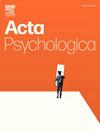青年、中年和老年人情感体验和内隐表征:基于生态瞬间评价和内隐联想检验的证据
IF 2.1
4区 心理学
Q2 PSYCHOLOGY, EXPERIMENTAL
引用次数: 0
摘要
目前的研究使用生态瞬间评估(EMA)(经验抽样)、自我报告的情感效价偏好和内隐联想测试(IAT,测量情感效价的内隐心理表征)在印度背景下检验了成年人在情绪幸福感和情绪调节动机方面的年龄差异。研究结果显示,总体而言,人们更倾向于积极的影响,日常生活中的愉悦感,而且亲享乐动机比反享乐动机更普遍。中老年人报告的积极情绪体验多于消极情绪体验,(t[87] = 4.77, p = 0.013)和(t[87] = 13.93, p <;.001),这可能归因于情感上有意义的目标动机的变化,与社会情感选择理论相一致。在IAT测试中,老年人正面和负面情绪效价差异显著(D1得分分别高于年轻人(2.35分)和中年人(2.15分)(t[27] = - 2.56分,p = .007)和中年人(t[27] = - 2.93分,p = .002),这可能受到认知控制和情绪调节动机的调节。此外,在本研究的三个年龄组中,很少报告了混合情绪(为快乐而悲伤或享受悲伤)和反享乐动机(与迄今为止在西方队列中观察到的情况相比)的情况(年龄×动机×效价,F[2,87] = 1.77)。p = .17)。我们观察到,在积极与消极情感体验方面,不同年龄组的异质性降低,对情感效价的偏好具有更大的可辨析性(结果基于主成分分析)。因此,在中老年人中,情感体验被发现更强烈地定义为积极情感。中老年人情感目标向积极情感的转变与情感效价的独特心理表征有关。本文章由计算机程序翻译,如有差异,请以英文原文为准。
Affective experiences and implicit representation of affect valence in young, middle-aged and older adults: Evidence based on ecological momentary assessment and implicit association test
The current study examined adult age differences in emotional well-being and emotion-regulation motivation in the Indian context using the ecological momentary assessment (EMA) (experience sampling), self-reported preferences for affect-valence and the Implicit Association Test (IAT, to measure implicit mental representations of affect valence) across three age groups. Findings reveal an overall preference for positive affect, feeling of pleasantness in daily life and a greater prevalence for pro-hedonic than contra-hedonic motivation. Middle-aged and older adults reported greater experience of positive than negative affect, (t[87] = 4.77, p = .013) and (t[87] = 13.93, p < .001, respectively) compared to younger adults, which may be attributed to changes in the motivation for emotionally meaningful goals, consistent with the socioemotional selectivity theory. The IAT showed a greater distinctiveness between positive and negative affect valence among older adults than middle-aged and young adults (greater D1 scores among older adults than younger (2.35) and middle-aged adults (2.15) (t[27] = −2.56, p = .007) and (t[27] = −2.93, p = .002), respectively), which may be modulated by cognitive control and motivation for emotion regulation. Additionally, very few instances of mixed affect (feeling sad to be happy or enjoying being sad) and contra-hedonic motivation (in comparison to what has been observed so far in western cohorts) were reported across the three age groups in this study (age × motivation × valence, F[2, 87] = 1.77. p = .17). We observed reductions in heterogeneity and a greater discriminability with respect to positive versus negative affective experiences and in the preferences for affect valence across age groups (results based on principal component analysis). Thus, affective experiences were found to be more strongly defined by positive affect among middle-aged and older adults. This shift in emotional goals towards positive affect among middle-aged and older adults is associated with distinctive mental representations of affect valence.
求助全文
通过发布文献求助,成功后即可免费获取论文全文。
去求助
来源期刊

Acta Psychologica
PSYCHOLOGY, EXPERIMENTAL-
CiteScore
3.00
自引率
5.60%
发文量
274
审稿时长
36 weeks
期刊介绍:
Acta Psychologica publishes original articles and extended reviews on selected books in any area of experimental psychology. The focus of the Journal is on empirical studies and evaluative review articles that increase the theoretical understanding of human capabilities.
 求助内容:
求助内容: 应助结果提醒方式:
应助结果提醒方式:


